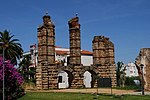Roman Forum (Mérida)

The Roman Forum is an archaeological area in Mérida, Spain. It was the main public area of the Roman city of Emerita Augusta, founded in 25 BC by Emperor Augustus. The city had another forum, the Provincial Forum, built in 50 AD. Together with the other archaeological sites of the city, it was inscribed in the UNESCO World Heritage List in 1993. Mérida, or Emerita Augusta in Latin, was once the capital of the Lusitania imperial province that included most of Portugal as well as the western central portion of Spain. It contains many common places found in a Roman city: buildings such as theatres, temples, forums, and arenas. Mérida’s ruins are mostly still intact, despite the passage of time of approximately 2,000 years. Mérida preserves more important ancient Roman monuments than any other city in Spain
Excerpt from the Wikipedia article Roman Forum (Mérida) (License: CC BY-SA 3.0, Authors, Images).Roman Forum (Mérida)
Calle Sagasta, Merida San Antonio
Geographical coordinates (GPS) Address External links Nearby Places Show on map
Geographical coordinates (GPS)
| Latitude | Longitude |
|---|---|
| N 38.916944444444 ° | E -6.3431388888889 ° |
Address
Foro Romano
Calle Sagasta
06808 Merida, San Antonio
Extremadura, Spain
Open on Google Maps











